How to Install LEMP Stack on Ubuntu 22.04 Server/Desktop
This tutorial is going to show you how to install LEMP stack (Nginx, MariaDB, and PHP8.1) on Ubuntu 22.04. A software stack is a set of software tools bundled together. LEMP stands for Linux, Nginx (Engine-X), MariaDB/MySQL, and PHP, all of which are open source and free to use.
It is the most common software stack that powers dynamic websites and web applications.
- Linux is the operating system.
- Nginx is the web server.
- MariaDB/MySQL is the database server.
- PHP is the server-side scripting language responsible for generating dynamic web pages.
Requirements
To follow this tutorial, you need an Ubuntu 22.04 OS running on your local computer or on a remote server.
If you are looking for a virtual private server (VPS), I recommend Kamatera VPS, which features:
- 30 days free trial.
- Starts at $4/month (1GB RAM)
- High-performance KVM-based VPS
- 9 data centers around the world, including United States, Canada, UK, Germany, The Netherlands, Hong Kong, and Isreal.
Follow the tutorial linked below to create your Linux VPS server at Kamatera.
Once you have a VPS running Ubuntu 22.04, follow the instructions below.
And if you need to set up LEMP stack with a domain name, I recommend buying domain names from NameCheap because the price is low and they give whois privacy protection free for life.
Step 1: Update Software Packages
Before we install the LEMP stack, it’s a good practice to update the repository and software packages by running the following commands on your Ubuntu 22.04 OS.
sudo apt update sudo apt upgrade -y
Step 2: Install Nginx Web Server
Nginx is a high-performance web server and is very popular these days. It also can be used as a reverse proxy and caching server. Enter the following command to install Nginx Web server.
sudo apt install nginx
After it’s installed, we can enable Nginx to auto-start at boot time by running the following command.
sudo systemctl enable nginx
Then start Nginx with this command:
sudo systemctl start nginx
Now check out its status.
sudo systemctl status nginx
Output:
● nginx.service - A high performance web server and a reverse proxy server Loaded: loaded (/lib/systemd/system/nginx.service; enabled; vendor preset: enabled) Active: active (running) since Fri 2022-04-10 14:11:43 UTC; 3s ago Docs: man:nginx(8) Process: 8533 ExecStartPre=/usr/sbin/nginx -t -q -g daemon on; master_process on; (code=exited, status=0/SUCCESS) Process: 8545 ExecStart=/usr/sbin/nginx -g daemon on; master_process on; (code=exited, status=0/SUCCESS) Main PID: 8549 (nginx) Tasks: 3 (limit: 9451) Memory: 3.9M CGroup: /system.slice/nginx.service ├─8549 nginx: master process /usr/sbin/nginx -g daemon on; master_process on; ├─8550 nginx: worker process └─8551 nginx: worker process
“Enabled” indicates that auto-start at boot time is enabled and we can see that Nginx is running. You can also see how much RAM Nginx is using from the output. If the above command doesn’t immediately quit after running. You need to press “q” to make it quit.
Check Nginx version.
nginx -v
Output:
nginx version: nginx/1.18.0 (Ubuntu)
Now type in the public IP address of your Ubuntu 22.04 server in the browser address bar. You should see the “Welcome to Nginx” Web page, which means Nginx Web server is running properly. If you are installing LEMP on your local Ubuntu 22.04 computer, then type 127.0.0.1 or localhost in the browser address bar.

If the connection is refused or failed to complete, there might be a firewall preventing incoming requests to TCP port 80. If you are using iptables firewall, then you need to run the following command to open TCP port 80.
sudo iptables -I INPUT -p tcp --dport 80 -j ACCEPT
If you are using the UFW firewall, then run this command to open TCP port 80.
sudo ufw allow http
Finally, we need to make www-data (Nginx user) as the owner of web directory. By default, it’s owned by the root user.
sudo chown www-data:www-data /usr/share/nginx/html -R
Step 3: Install MariaDB Database Server
MariaDB is a drop-in replacement for MySQL. It is developed by former members of MySQL team who are concerned that Oracle might turn MySQL into a closed-source product. Enter the following command to install MariaDB on Ubuntu 22.04.
sudo apt install mariadb-server mariadb-client
After it’s installed, MariaDB server should be automatically started. Use systemctl to check its status.
systemctl status mariadb
Output:
● mariadb.service - MariaDB 10.6.7 database server Loaded: loaded (/lib/systemd/system/mariadb.service; enabled; vendor preset: enabled) Active: active (running) since Fri 2022-04-10 14:19:16 UTC; 18s ago Docs: man:mysqld(8) https://mariadb.com/kb/en/library/systemd/ Main PID: 9161 (mysqld) Status: "Taking your SQL requests now..." Tasks: 31 (limit: 9451) Memory: 64.7M CGroup: /system.slice/mariadb.service └─9161 /usr/sbin/mysqld
Hint: If the above command doesn’t immediately quit after running. You need to press “q” to make it quit.
If it’s not running, start it with this command:
sudo systemctl start mariadb
To enable MariaDB to automatically start at boot time, run
sudo systemctl enable mariadb
Now run the post-installation security script.
sudo mysql_secure_installation
- When it asks you to enter MariaDB root password, press
Enterkey as the root password isn’t set yet. - Don’t switch to unix_socket authentication because MariaDB is already using unix_socket authentication.
- Don’t change the root password, because you don’t need to set root password when using unix_socket authentication.
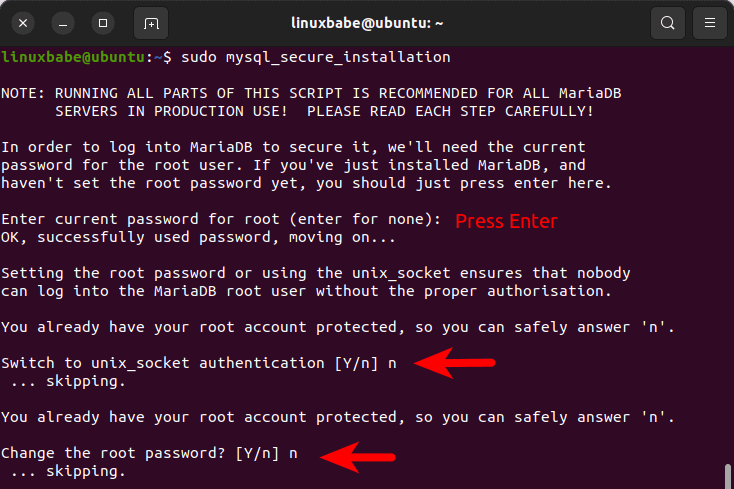
Next, you can press Enter to answer all remaining questions, which will remove anonymous user, disable remote root login and remove test database. This step is a basic requirement for MariaDB database security. (Notice that Y is capitalized, which means it is the default answer. )
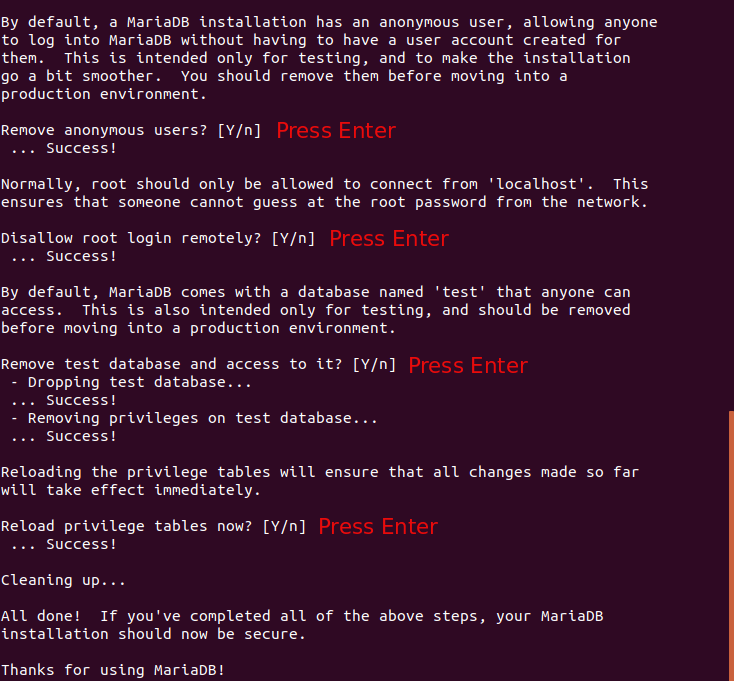
By default, the MaraiDB package on Ubuntu uses unix_socket to authenticate user login, which basically means you can use username and password of the OS to log into MariaDB console. So you can run the following command to log in without providing MariaDB root password.
sudo mariadb -u root
To exit, run
exit;
Check MariaDB server version information.
mariadb --version
As you can see, we have installed MariaDB 10.6.7.
mariadb Ver 15.1 Distrib 10.6.7-MariaDB, for debian-linux-gnu (x86_64) using EditLine wrapper
Step 4: Install PHP8.1
PHP8.1 is included in Ubuntu 22.04 repository and has a minor performance improvement over PHP8.0. Enter the following command to install PHP8.1 and some common extensions.
sudo apt install php8.1 php8.1-fpm php8.1-mysql php-common php8.1-cli php8.1-common php8.1-opcache php8.1-readline php8.1-mbstring php8.1-xml php8.1-gd php8.1-curl
PHP extensions are commonly needed for content management systems (CMS) like WordPress. For example, if your installation lacks php8.1-xml, then some of your WordPress site pages may be blank and you can find an error in Nginx error log like:
PHP message: PHP Fatal error: Uncaught Error: Call to undefined function xml_parser_create()
Installing these PHP extensions ensures that your CMS runs smoothly. Now start php8.1-fpm.
sudo systemctl start php8.1-fpm
Enable auto-start at boot time.
sudo systemctl enable php8.1-fpm
Check status:
systemctl status php8.1-fpm
Sample output:
● php8.1-fpm.service - The PHP 8.1 FastCGI Process Manager Loaded: loaded (/lib/systemd/system/php8.1-fpm.service; enabled; vendor pr> Active: active (running) since Fri 2022-04-10 14:40:26 UTC; 12s ago Docs: man:php-fpm8.1(8) Process: 21019 ExecStartPost=/usr/lib/php/php-fpm-socket-helper install /ru> Main PID: 21012 (php-fpm8.1) Status: "Processes active: 0, idle: 2, Requests: 0, slow: 0, Traffic: 0req> Tasks: 3 (limit: 9451) Memory: 9.4M CGroup: /system.slice/php8.1-fpm.service ├─21012 php-fpm: master process (/etc/php/8.1/fpm/php-fpm.conf) ├─21017 php-fpm: pool www └─21018 php-fpm: pool www
If the above command doesn’t immediately quit after running. You need to press “q” to make it quit.
Step 5: Create an Nginx Server Block
An Nginx server block is like a virtual host in Apache. We will not use the default server block because it’s inadequate to run PHP code and if we modify it, it becomes a mess. So remove the default symlink in sites-enabled directory by running the following command. (It’s still available as /etc/nginx/sites-available/default.)
sudo rm /etc/nginx/sites-enabled/default
Then use a command-line text editor like Nano to create a new server block file under /etc/nginx/conf.d/ directory.
sudo nano /etc/nginx/conf.d/default.conf
Paste the following text into the file. The following snippet will make Nginx listen on IPv4 port 80 and IPv6 port 80 with a catch-all server name.
server {
listen 80;
listen [::]:80;
server_name _;
root /usr/share/nginx/html/;
index index.php index.html index.htm index.nginx-debian.html;
location / {
try_files $uri $uri/ /index.php;
}
location ~ \.php$ {
fastcgi_pass unix:/run/php/php8.1-fpm.sock;
fastcgi_param SCRIPT_FILENAME $document_root$fastcgi_script_name;
include fastcgi_params;
include snippets/fastcgi-php.conf;
}
# A long browser cache lifetime can speed up repeat visits to your page
location ~* \.(jpg|jpeg|gif|png|webp|svg|woff|woff2|ttf|css|js|ico|xml)$ {
access_log off;
log_not_found off;
expires 360d;
}
# disable access to hidden files
location ~ /\.ht {
access_log off;
log_not_found off;
deny all;
}
}
Save and close the file. (To save a file in Nano text editor, press Ctrl+O, then press Enter to confirm. To exit, press Ctrl+X.)
Then test Nginx configurations.
sudo nginx -t
If the test is successful, reload Nginx.
sudo systemctl reload nginx
Step 6: Test PHP
To test PHP-FPM with Nginx Web server, we need to create a info.php file in the webroot directory.
sudo nano /usr/share/nginx/html/info.php
Paste the following PHP code into the file.
<?php phpinfo(); ?>
Save and close the file. Now in the browser address bar, enter server-ip-address/info.php. Replace sever-ip-address with your actual IP. If you follow this tutorial on your local computer, then type 127.0.0.1/info.php or localhost/info.php.
You should see your server’s PHP information. This means PHP scripts can run properly with Nginx web server.
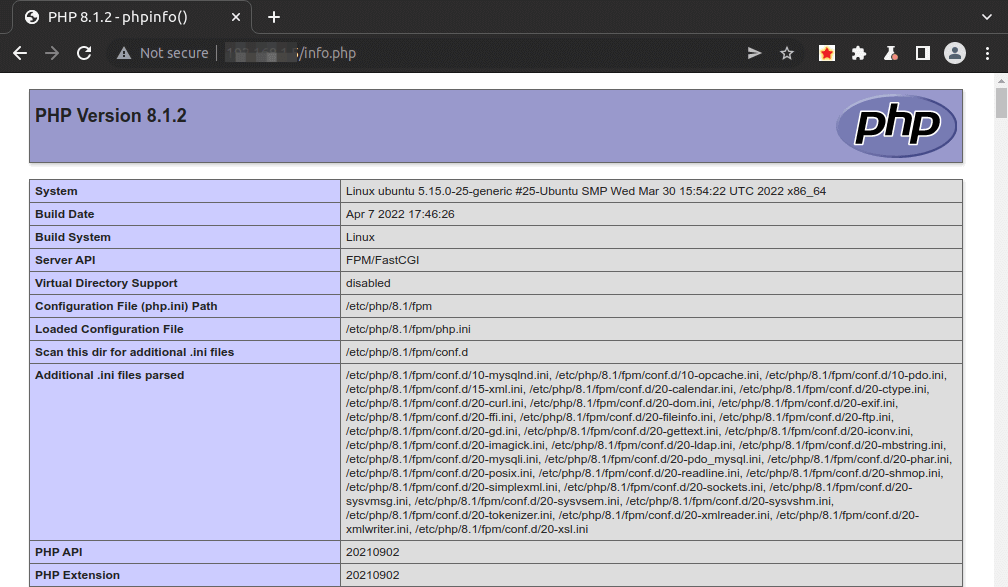
Step 7: Improve PHP Performance
The default PHP configurations (/etc/php/8.1/fpm/php.ini) are made for servers with very few resources (like a 256MB RAM server). To improve web application performance, you should change some of them.
We can edit the PHP config file (php.ini), but it’s a good practice to create a custom PHP config file, so when you upgrade to a new version of PHP8.1, your custom configuration will be preserved.
sudo nano /etc/php/8.1/fpm/conf.d/60-custom.ini
In this file, add the following lines.
; Maximum amount of memory a script may consume. Default is 128M memory_limit = 512M ; Maximum allowed size for uploaded files. Default is 2M. upload_max_filesize = 20M ; Maximum size of POST data that PHP will accept. Default is 2M. post_max_size = 20M ; The OPcache shared memory storage size. Default is 128 opcache.memory_consumption=256 ; The amount of memory for interned strings in Mbytes. Default is 8. opcache.interned_strings_buffer=32
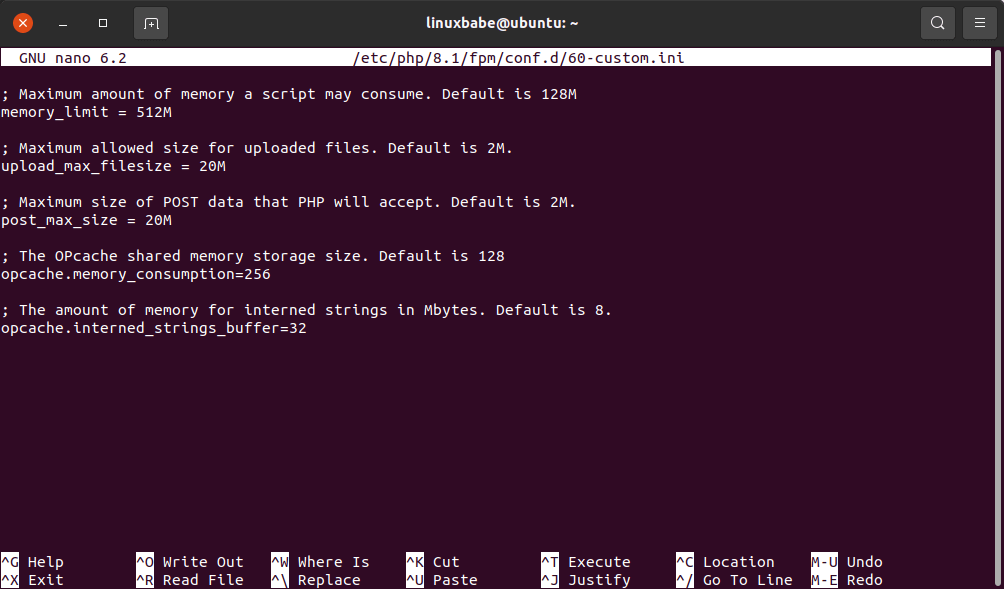
Save and close the file. Then reload PHP8.1-FPM for the changes to take effect.
sudo systemctl reload php8.1-fpm
OPcache improves the performance of PHP applications by caching precompiled bytecode. You can view OPcache stats via the info.php page. Below is a before and after comparison on one of my servers.
Before
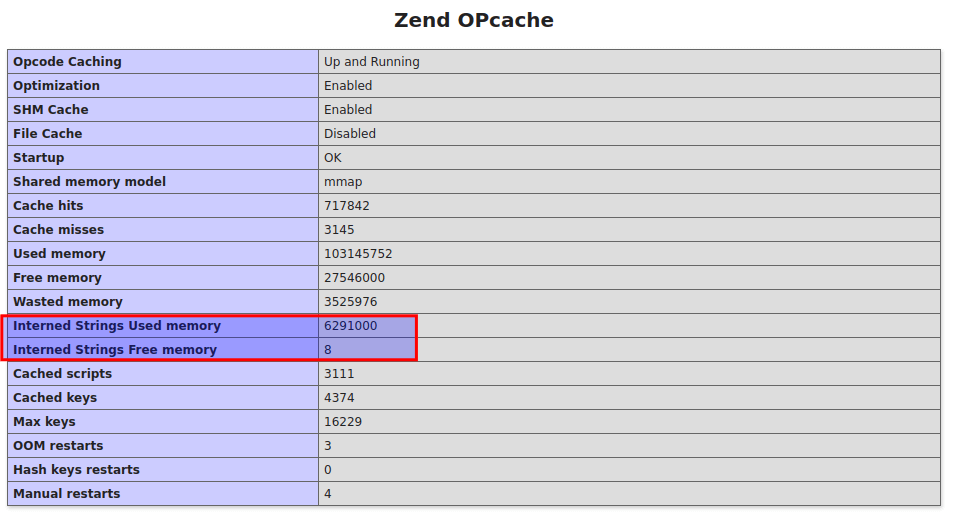
After
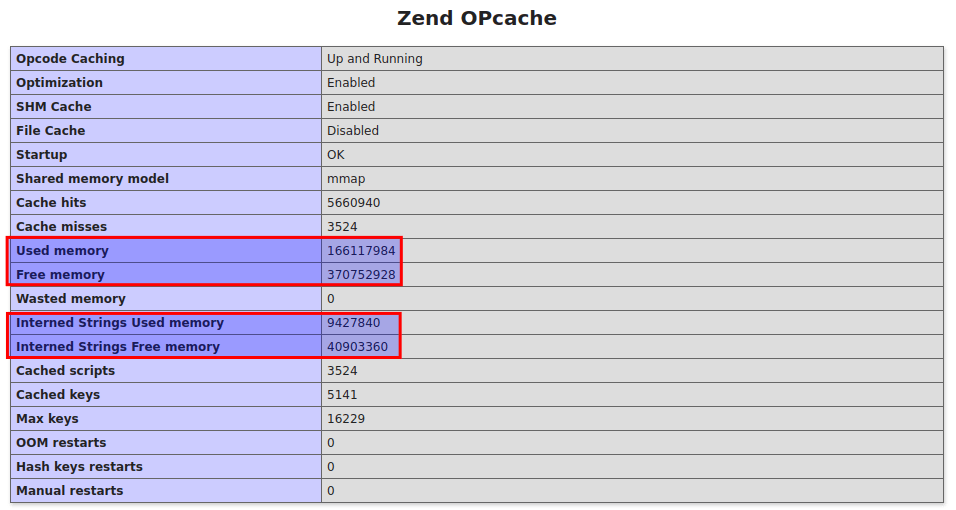
As you can see, before applying the custom PHP configuration, the RAM allocated to OPcache is almost used up. After applying the custom PHP configurations, OPcache is able to use more RAM for caching precompiled bytecode.
Congrats! You have successfully installed Nginx, MariaDB, and PHP8.1 on Ubuntu 22.04. For your server’s security, you should delete info.php file now to prevent hackers from seeing it.
sudo rm /usr/share/nginx/html/info.php
Troubleshooting Tip
If you encounter errors, you can check the Nginx error log (/var/log/nginx/error.log) to find out what’s wrong.
Nginx Automatic Restart
If for any reason your Nginx process is killed, you need to run the following command to restart it.
sudo systemctl restart nginx
Instead of manually typing this command, we can make Nginx automatically restart by editing the nginx.service systemd service unit. To override the default systemd service configuration, we create a separate directory.
sudo mkdir -p /etc/systemd/system/nginx.service.d/
Then create a file under this directory.
sudo nano /etc/systemd/system/nginx.service.d/restart.conf
Add the following lines in the file, which will make Nginx automatically restart 5 seconds after a failure is detected. The default value of RetartSec is 100ms, which is too small. Nginx may complain that “start request repeated too quickly” if RestartSec is not big enough.
[Service] Restart=always RestartSec=5s
Save and close the file. Then reload systemd for the changes to take effect.
sudo systemctl daemon-reload
To check if this would work, kill Nginx with:
sudo pkill nginx
Then check Nginx status. You will find Nginx automatically restarted.
systemctl status nginx
MariaDB Automatic Start
By default, MariaDB is configured to automatically restart on-abort (/lib/systemd/system/mariadb.service). However, if your server runs out of memory (oom) and MariaDB is killed by the oom killer, it won’t automatically restart. We can configure it to restart no matter what happens.
Create a directory to store custom configurations.
sudo mkdir -p /etc/systemd/system/mariadb.service.d/
Create a custom config file.
sudo nano /etc/systemd/system/mariadb.service.d/restart.conf
Add the following lines in the file.
[Service] Restart=always RestartSec=5s
Save and close the file. Then reload systemd for the changes to take effect.
sudo systemctl daemon-reload
Next Steps
As always, if you found this post useful, then subscribe to our free newsletter to get more tips and tricks. You can also install WordPress on top of the LEMP stack to create your own website or blog.
Related Nginx tutorials:
Backup is important in case of hacking, data center disasters, etc. You should have a backup strategy for your server.
- Back Up and Restore MariaDB Databases From the Command line
- Use Duplicati to Back Up Files on Debian, Ubuntu, Linux Mint
Linux Server Performance Tuning and Monitoring
- Easily Boost Ubuntu Network Performance by Enabling TCP BBR
- What is HTTP/2 and How to Enable it on Nginx
- Linux Server Performance Monitoring with Netdata (2022)
Take care 🙂



Thanks so much for this. It saved me a heap of googling 🙂
Glad it helped you 🙂
Good job but I am wondering why you choose /usr/share/nginx/html/ instead of /var/www/html?
/var/www/html is an Apache tradition. Nginx officially recommends /usr/share/nginx/html.
Great walkthrough, saved me a ton of time ThanQ
p.s. the auto anable steps for the stack aren’t necessary, they are set by default.
Thank you very much. Everything is clear and consice explained.
also changed a line in nginx default.conf to read like this:
this gets rid of a trivial error message in the log
Hello, if I would wanna change the main page of my domain, currently it’s showing “Welcome to Nginx” and a little text, i should change the files in /usr/share/nginx/html OR /var/www/html ??? I really need your help, please answer asap!!
If your Nginx configuration file set the web root to /usr/share/nginx/html/, then you should change the files in /usr/share/nginx/html/.
If you copy the configurations from this article, then your web root is set to /usr/share/nginx/html/.
I don’t need to change anything in /var/www/html ???
If you set web root to /usr/share/nginx/html/, you should put your html and php files to this directory, and there’s no need to change anything in /var/www/html/.
If you set web root to /var/www/html/, then you should put html and php files to this directory, and there’s no need to change anything in /usr/share/nginx/html/.
sudo chown www-data /usr/share/nginx/html -R
Is this the part I set my web root to /usr/share/nginx/html/ ?
The web root is set in Nginx configuration file, in this case the /etc/nginx/conf.d/default.conf file. The following line indicates that web root is set to /usr/share/nginx/html/.
This command:
is just to make sure Nginx can write to this directory.
Hi,
Great tutorial.
I followe all the steps and is working.
I have one porblem, after this tutorial I was trying to setup Nginx chache and also Rednis. I do not like wordpress chaching plugins, I better prefer a back end chaching system. But I am having trouble because every time I change something to my page is not reflecting after I restart.
Can you make a full tutorial on setting LEMP and also WordPress and hardening Nginx and how to setup chache.
I find tutorials around only for beggineres but nothing that can be a full setup.
Thank you.
Hi Adlion,
You can follow the tutorial below to set up Nginx FastCGI cache, so you don’t need to install caching plugin in WordPress.
Set Up Nginx FastCGI Cache to Reduce WordPress Server Response Time
tried so many but only this one works!!! great job!
thank you Lao Xiao
Thank you!
thanks for sharing
Perfect explanation. I follow and got zero errors or issues!
Another perfect instruction as always!
✰✰✰✰✰✰✰✰✰✰✰✰✰✰✰✰✰✰✰✰✰✰✰✰✰✰✰✰✰✰✰✰✰✰✰✰✰✰✰✰✰✰✰✰✰✰✰✰✰
5 stars is too low to rate this tutorial.
Thanks a lot!
Hi again,
I have installed phpmyadmin as per your instruction while Nginx version installed is 1.23.4. Maybe because of this version command sudo nginx -t resulted following error:
:~$ sudo nginx -t
nginx: [emerg] open() “/etc/nginx/snippets/fastcgi-php.conf” failed (2: No such file or directory) in /etc/nginx/conf.d/phpmyadmin.conf:23
nginx: configuration file /etc/nginx/nginx.conf test failed
Please advise how I can fix this error.
Thanks
Really excellent article. Concise and lucid. Thank you very much.
Hi Xiao, thanks for the great guide! I’m using your guide when setting up my servers. One thing I noticed is my website also became available on IP, but there must be default Nginx page instead. How it can be fixed?
In the
/etc/nginx/conf.d/default.conffile, changelisten 80;tolisten 80 default_server;. Then reload Nginx. This way, when a visitor enters the IP address of your server, Nginx will choose the default virtual host instead of your website.Yeah, I already found it out, thanks for the tutorial and this small fix!